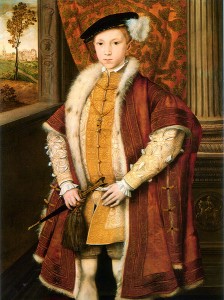 On this day in history, 20th February 1547, King Edward VI was crowned King at Westminster Abbey. However, the celebrations had begun the day before…
On this day in history, 20th February 1547, King Edward VI was crowned King at Westminster Abbey. However, the celebrations had begun the day before…
On the afternoon of Saturday the 19th February, the boy King processed out of the Tower of London. He was dressed in white velvet, which was embroidered with silver thread and decorated with lovers’ knots made from pearls, along with diamonds and rubies. He also had a gown of gold mesh and a sable cape, and the horse upon which he rode had been dressed in crimson satin decorated with pearls.
The procession consisted of the King’s messengers, the King’s gentlemen, his trumpeters, his chaplains and esquires of the body, all walking. Then came the nobility on horseback and members of the council paired with foreign diplomats. After them, processed the gentlemen ushers and Henry Grey, the Marquis of Dorset and Constable of England, bearing the sword of state. Finally, there was the nine year old king, Edward VI, escorted by the Duke of Somerset (his uncle, Edward Seymour) and the Earl of Warwick (John Dudley). They were followed by the Sir Anthony Browne (the King’s master of the horse), the henchmen, the Gentlemen of the Privy Chamber, the pensioners and the guard.
Edward VI’s biographer, Chris Skidmore, writes of how Cheapside was richly decorated with cloth of silver and gold, but that some of the pageants arranged for the day, at very short notice, “turned into shambles”. One pageant drew on the coronation of Henry VI as King of France in 1432, another boy king, and another made use of Jane Seymour’s phoenix, Henry VIII’s lion and the roses and hawthorn bush devices of the Tudor dynasty. Skidmore describes how the phoenix descended from the heavens to land on a mount decorated by red and white roses and hawthorn bushes. A crowned lion then approached, followed by a young cub. At the cub’s appearance, two angels descended and crowned him with an imperial crown. The phoenix and lion then departed, leaving the crowned cub alone.
Other displays along the route included depictions of Edward the Confessor, St George and “Truth”, a child representing the New Religion. Skidmore writes of how the young king particularly enjoyed watching a tightrope walker, who balanced along a cable as he descended to kiss the King’s foot.
The next day, at 9am, King Edward VI travelled to Whitehall by barge. He was met by the guard and pensioners and then he walked to the chamber of the Court of Augmentations, where he put on his Parliament robes of ermine trimmed crimson velvet. The King then processed to Westminster Abbey for the coronation ceremony under a canopy carried by the barons of the Cinque Ports. He was flanked by the Earl of Shrewsbury and the Bishop of Durham, and followed by John Dudley, William Parr and Thomas Seymour, who all bore his train. Behind them processed the Gentlemen of the Privy Chamber, the nobility, the pensioners, the guard and the court servants.
A dais had been erected in the richly decorated Abbey. On it, was a throne decorated in damask and gold, with two cushions to help raise the small King. The traditional coronation ceremony, used since 1375, had been adapted for the boy King. Instead of twelve hours, it would be seven. Thomas Cranmer, Archbishop of Canterbury, had also changed the coronation oath so that “reformation of the Church could now be enabled by royal prerogative, the king as lawmaker”. The changes were explained in a sermon by Cranmer, who also likened Edward to the Biblical Josiah, and then the young king was anointed and crowned with the St Edward’s crown, the imperial crown and a custom-made lighter crown. Edward then held the orb, the sceptre, St Edward’s staff and the spurs. He was King and the nobility now came before him, one by one, to kiss his left cheek.
The coronation ceremony was followed by a banquet in Westminster’s Great Hall, more feasting and entertainment at Whitehall, and then two days of jousting and feasting. Those Tudors knew how to celebrate!
Chris Skidmore writes of how “Edward was like no other king that had gone before him” because he had been born with the title of Defender of the Faith and was the first king “to be crowned with the powers that the royal supremacy brought with it; no king, before or since, was ever given such an unequivocal mandate for absolute rule.” How sad that Edward never got the chance to rule by himself. He died on the 6th July 1553 at the age of fifteen.
Edward VI’s Coronation Medal
Amongst the artefacts housed in the British Museum is Edward VI’s coronation medal, the first coronation medal produced in England. You can see photos of it and find out more about it at http://www.britishmuseum.org/explore/highlights/highlight_objects/cm/e/edward_vi_coronation_medal.aspx
Notes and Sources
- Edward VI: The Lost King of England, Chris Skidmore, p56-63
Also on this day in history…
- 1516 – Baptism of Princess Mary, the future Mary I, in the Church of the Observant Friars at Greenwich. The princess was carried to the font by the Countess of Surrey and her godparents were Catherine Courtenay, Countess of Devon and daughter of Edward IV; Margaret Pole, Countess of Salisbury and daughter of George, Duke of Clarence; the Duchess of Norfolk and Cardinal Thomas Wolsey.
- 1552 – Death of Anne Herbert, sister of Catherine Parr and wife of William Herbert, 1st Earl of Pembroke. Anne died at Baynard’s Castle and was buried in St Paul’s. Anne was a maid of honour to Jane Seymour, keeper of the jewels to Catherine Howard and was serving the Lady Mary (future Mary I) at the time of her death.